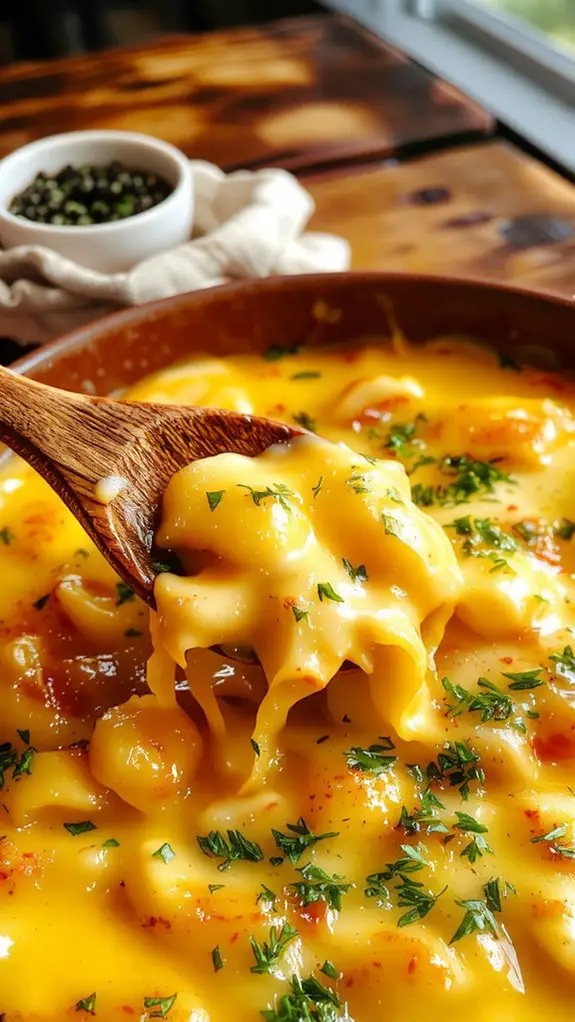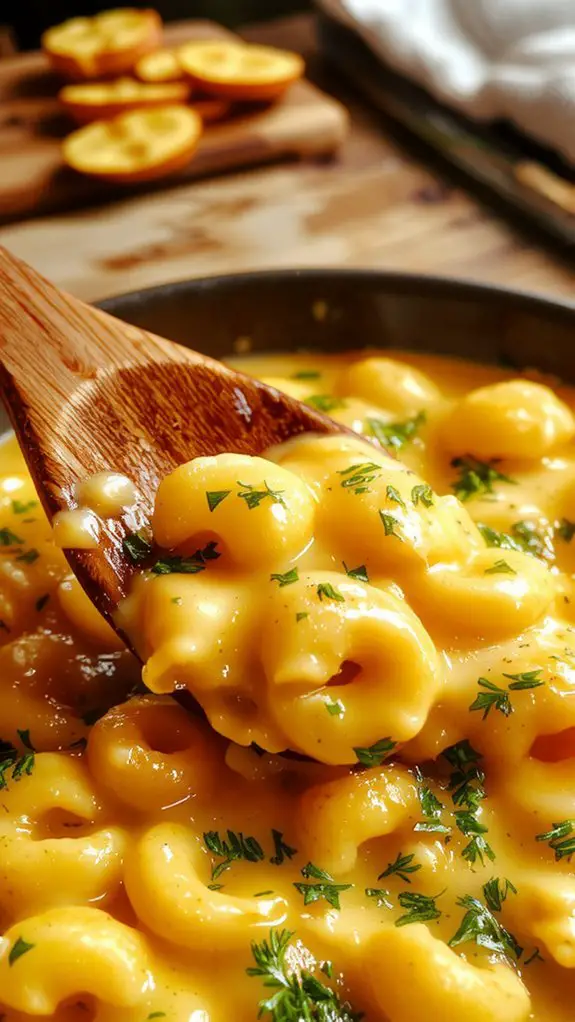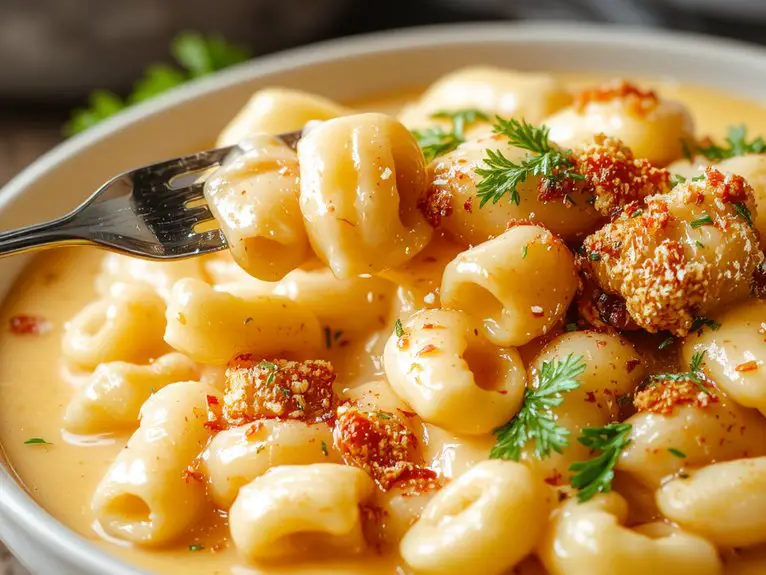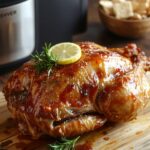I’ve always believed that mac and cheese is more than just a dish—it’s a feeling. Finding the perfect balance of creamy cheese sauce, perfectly cooked pasta, and a crispy topping can feel like solving a delicious puzzle. Over the years, I’ve tweaked and tested recipes to create what I think is the ultimate version. If you’re curious about the secrets to achieving that flawless texture and flavor, let’s explore the details together.
Recipe
This mac and cheese recipe is the ultimate comfort food—creamy, cheesy, and unapologetically indulgent. After countless tweaks and taste tests, I can confidently say this is the one you’ll want to save and make again and again.
The secret? A velvety cheese sauce made with sharp cheddar and Gruyère, perfectly balanced with a hint of Dijon mustard for a subtle tang. It’s baked to golden perfection, with a crispy breadcrumb topping that gives way to gooey, melty goodness underneath.
Whether it’s a cozy weeknight dinner or a crowd-pleasing side dish, this mac and cheese is guaranteed to hit the spot. Trust me, once you try it, you’ll understand why it’s become a staple in my kitchen—and it’s easier to make than you might think. Let’s get cooking!
Ingredients
The secret to next-level mac and cheese lies in balancing rich creaminess with bold flavor—and it starts with the right ingredients. While you can tweak this recipe to fit what’s in your pantry, a few key players are non-negotiable for that velvety, crave-worthy result.
- Elbow macaroni: The classic choice—its curves trap cheese sauce perfectly. *Swap with cavatappi or shells if you want extra nooks for sauce.*
- Sharp cheddar: Aged cheddar melts smoothly and packs a tangy punch. *Avoid pre-shredded cheese (anti-caking agents make the sauce grainy).*
- Gruyère: The VIP for depth and nuttiness. *No Gruyère? Try Emmental or Fontina.*
- Whole milk or half-and-half: Higher fat = silkier texture. *Skim milk will leave the sauce thin and sad.*
- Butter: Unsalted, so you control the seasoning. *Never margarine—it’s a flavor killer.*
- Flour: All-purpose for a foolproof roux (the sauce’s backbone). *Gluten-free? Use cornstarch slurry instead.*
- Dijon mustard: Just a teaspoon brightens the richness. *Yellow mustard works in a pinch.*
- Freshly grated nutmeg: A pinch elevates the cheese flavor. *Skip the pre-ground stuff—it’s stale.*
- Panko breadcrumbs: For the crispiest topping. *No panko? Crushed Ritz crackers add buttery crunch.*
- Hot sauce (optional): A dash of Frank’s or Tabasco cuts through the richness. *Trust us.*
Pro move: Grate your own cheese—it melts better than pre-shredded.
And if you’re feeling fancy, a sprinkle of smoked paprika or truffle salt takes it from cozy to gourmet.
How to Make the Best Classic Cheddar Mac

– Boil the Pasta: Start by bringing a large pot of salted water to a rolling boil. Add the macaroni and cook until it’s al dente, about 8-10 minutes. Overcooking can make the pasta mushy, so keep an eye on it and taste-test for the perfect texture.
Pro Tip: Salting the water generously seasons the pasta from within, eliminating bland bites.
– Make the Roux: While the pasta cooks, melt butter in a saucepan over medium heat. Once melted, whisk in an equal amount of flour to create a roux. Cook this mixture for 1-2 minutes to remove the raw flour taste, but avoid browning it—this is the base for your creamy cheese sauce.
Watch Out: Don’t rush this step—cooking the roux guarantees a smooth, lump-free sauce.
– Add Milk Gradually: Slowly pour in warm milk, whisking constantly to avoid lumps. Bring the mixture to a gentle simmer, stirring occasionally, until it thickens slightly. This creates a velvety base for your cheese.
Why It Matters: Adding milk gradually prevents clumping and guarantees a silky texture.
– Incorporate the Cheese: Remove the saucepan from heat and stir in shredded cheddar cheese until fully melted. For extra creaminess, add a splash of milk if the sauce feels too thick.
Pro Tip: Use freshly shredded cheese—pre-shredded varieties often contain anti-caking agents that can make the sauce grainy.
– Combine Pasta and Sauce: Drain the cooked macaroni thoroughly, then return it to the pot. Pour the cheese sauce over the pasta and gently mix until every piece is coated. Avoid overmixing, as this can break down the pasta.
Visual Cue: The pasta should be evenly coated with a glossy, creamy sauce.
– Optional Add-Ins: For extra flair, consider folding in cooked bacon, breadcrumbs, or a sprinkle of parsley. This step is customizable based on your preferences.
Flexibility: Feel free to experiment with mix-ins or toppings to make the dish your own.
– Serve Immediately: Dish up the mac and cheese while it’s warm and creamy for the best experience. If it sits too long, the sauce may thicken further.
Pro Tip: For a golden crust, transfer the mixture to a baking dish, top with extra cheese or breadcrumbs, and broil for a few minutes.
Nutrition
Mac and cheese provides essential nutrients and energy. Here’s the nutritional breakdown per serving:
Calories: 300
Total Fat: 12g
Saturated Fat: 7g
Cholesterol: 35mg
Sodium: 450mg
Total Carbohydrates: 33g
Dietary Fiber: 1g
Sugars: 5g
Protein: 12g
Chef Tips
When making mac and cheese, I always recommend using freshly grated cheese instead of pre-shredded for a smoother, creamier sauce. Don’t rush the roux—cook it until it’s golden to avoid a floury taste.
Stir constantly while adding milk to prevent lumps. For extra flavor, mix in a pinch of mustard powder or cayenne.
Always bake uncovered for a crispy top. Let it rest 5 minutes before serving.






